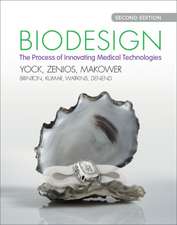Developing Biomedical Devices: Design, Innovation and Protection: SpringerBriefs in Applied Sciences and Technology
Autor Giuseppe Andreoni, Massimo Barbieri, Barbara Colomboen Limba Engleză Paperback – 15 oct 2013
Din seria SpringerBriefs in Applied Sciences and Technology
-
 Preț: 415.18 lei
Preț: 415.18 lei - 17%
 Preț: 360.33 lei
Preț: 360.33 lei -
 Preț: 376.22 lei
Preț: 376.22 lei -
 Preț: 380.07 lei
Preț: 380.07 lei -
 Preț: 141.23 lei
Preț: 141.23 lei - 20%
 Preț: 326.28 lei
Preț: 326.28 lei -
 Preț: 379.09 lei
Preț: 379.09 lei -
 Preț: 195.87 lei
Preț: 195.87 lei - 20%
 Preț: 293.83 lei
Preț: 293.83 lei -
 Preț: 409.43 lei
Preț: 409.43 lei -
 Preț: 344.90 lei
Preț: 344.90 lei -
 Preț: 355.48 lei
Preț: 355.48 lei -
 Preț: 264.79 lei
Preț: 264.79 lei -
 Preț: 382.32 lei
Preț: 382.32 lei -
 Preț: 380.07 lei
Preț: 380.07 lei -
 Preț: 355.65 lei
Preț: 355.65 lei - 20%
 Preț: 225.31 lei
Preț: 225.31 lei - 20%
 Preț: 386.11 lei
Preț: 386.11 lei -
 Preț: 378.12 lei
Preț: 378.12 lei -
 Preț: 378.12 lei
Preț: 378.12 lei -
 Preț: 377.57 lei
Preț: 377.57 lei -
 Preț: 377.95 lei
Preț: 377.95 lei - 20%
 Preț: 301.85 lei
Preț: 301.85 lei - 15%
 Preț: 462.51 lei
Preț: 462.51 lei -
 Preț: 141.98 lei
Preț: 141.98 lei -
 Preț: 377.18 lei
Preț: 377.18 lei -
 Preț: 355.92 lei
Preț: 355.92 lei -
 Preț: 382.95 lei
Preț: 382.95 lei -
 Preț: 378.12 lei
Preț: 378.12 lei -
 Preț: 378.12 lei
Preț: 378.12 lei -
 Preț: 344.90 lei
Preț: 344.90 lei -
 Preț: 380.07 lei
Preț: 380.07 lei -
 Preț: 380.29 lei
Preț: 380.29 lei -
 Preț: 312.68 lei
Preț: 312.68 lei -
 Preț: 382.95 lei
Preț: 382.95 lei -
 Preț: 356.42 lei
Preț: 356.42 lei -
 Preț: 376.59 lei
Preț: 376.59 lei -
 Preț: 412.30 lei
Preț: 412.30 lei -
 Preț: 479.67 lei
Preț: 479.67 lei -
 Preț: 376.59 lei
Preț: 376.59 lei -
 Preț: 273.63 lei
Preț: 273.63 lei - 20%
 Preț: 324.64 lei
Preț: 324.64 lei -
 Preț: 444.52 lei
Preț: 444.52 lei - 20%
 Preț: 288.73 lei
Preț: 288.73 lei -
 Preț: 261.91 lei
Preț: 261.91 lei -
 Preț: 381.98 lei
Preț: 381.98 lei - 20%
 Preț: 322.17 lei
Preț: 322.17 lei -
 Preț: 410.85 lei
Preț: 410.85 lei -
 Preț: 379.68 lei
Preț: 379.68 lei -
 Preț: 374.30 lei
Preț: 374.30 lei
Preț: 357.61 lei
Preț vechi: 376.43 lei
-5% Nou
Puncte Express: 536
Preț estimativ în valută:
68.45€ • 70.54$ • 57.79£
68.45€ • 70.54$ • 57.79£
Carte tipărită la comandă
Livrare economică 03-17 martie
Preluare comenzi: 021 569.72.76
Specificații
ISBN-13: 9783319012063
ISBN-10: 3319012061
Pagini: 92
Ilustrații: VIII, 82 p. 33 illus.
Dimensiuni: 155 x 235 x 5 mm
Greutate: 0.14 kg
Ediția:2014
Editura: Springer International Publishing
Colecția Springer
Seriile SpringerBriefs in Applied Sciences and Technology, PoliMI SpringerBriefs
Locul publicării:Cham, Switzerland
ISBN-10: 3319012061
Pagini: 92
Ilustrații: VIII, 82 p. 33 illus.
Dimensiuni: 155 x 235 x 5 mm
Greutate: 0.14 kg
Ediția:2014
Editura: Springer International Publishing
Colecția Springer
Seriile SpringerBriefs in Applied Sciences and Technology, PoliMI SpringerBriefs
Locul publicării:Cham, Switzerland
Public țintă
ResearchCuprins
Introduction.- Emerging issues in healthcare.- Innovation demand.- Innovation process and methods.- Innovation and Rights.- Intellectual Property Rights: terms, definitions.- Prior art and analysis of innovation.- What models for patenting.- What to do after the patent: transfer, licensing, spin-off, start-up.- Examples.- Case study.- Wearable systems and related IPR.
Notă biografică
Giuseppe Andreoni is assistant professor of Biomedical Engineering at the Politecnico di Milano, Italy. Currently he is director of the Campus Point and the co-ordinator of the Sensibilab (Biomedical Sensors and Systems Lab.) and of the Ly-PhE (Laboratory of Physical Ergonomics) at the Industrial Design Dept. of the Politecnico di Milano. He developed experience in the field of the biomedical and communication technologies applied to medicine and rehabilitation, and ergonomics with specific attention to the User-Centred-Design and Design-for-All philosophies. His main research topics are: ergonomics, wearable sensors, rehabilitation and assistive technology. In 2006 he founded SXT, a spin off company of Politecnico di Milano whose core business is the design and production of wearable biosignals monitoring devices for telemedicine. In 2010 he founded ComfTech, another spin off company of Politecnico di Milano whose core business is the design and production of sensorized garments for medical, sport and fitness applications and interactive edu-toys.
Textul de pe ultima copertă
During the past two decades incredible progress has been achieved in the instruments and devices used in the biomedical field. This progress stems from continuous scientific research that has taken advantage of many findings and advances in technology made available by universities and industry. Innovation is the key word, and in this context legal protection and intellectual property rights (IPR) are of crucial importance. This book provides students and practitioners with the fundamentals for designing biomedical devices and explains basic design principles. Furthermore, as an aid to the development of devices and products for healthcare, it presents a brief description of the human body, covering anatomy and physiology, that will assist the reader in understanding the origin of biosignals, their significance, and the technology to be used in their measurement. Issues concerning IPR and protections are also fully discussed, with examples and opportunities for IPR exploitation.
Caracteristici
Covers a broad range of interest, from design to engineering Explains intellectual property rights (IPR) and legal protection as well as the procedures Presents examples and opportunities for IPR exploitation Includes supplementary material: sn.pub/extras

















